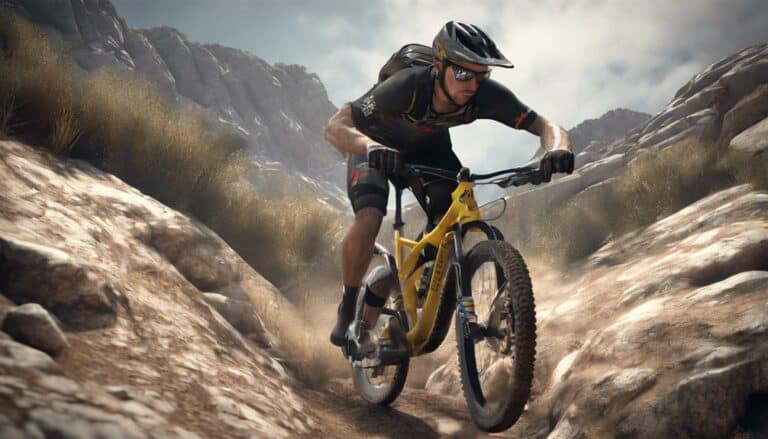When it comes to tailoring your training program for different types of enduro racing terrain, you've probably heard the saying, 'practice makes perfect.'
But how do you actually adapt your workouts to conquer rocky, uphill, fast, flowy, sandy, or muddy tracks effectively?
By understanding the nuances of each terrain type and customizing your training routines to address the specific challenges they present, you can elevate your performance to new heights.
So, let's explore some strategic training approaches to help you excel in diverse enduro racing environments and gain a competitive edge in your next race.
Key Takeaways
- Train for specific terrains like rocks, sand, and mud with tailored exercises.
- Focus on strength, endurance, and technique to excel in diverse enduro race conditions.
- Adapt bike setup and suspension for optimal performance on different terrains.
- Develop skills for speed, control, and power to navigate various enduro racing landscapes effectively.
Understanding Enduro Racing Terrain Types
When preparing for enduro racing, understanding the various types of terrain is essential for developing the necessary skills and techniques. Enduro races present a diverse range of terrains, from rocky trails to sandy tracks, each demanding specific strengths and abilities.
To excel in these races, a combination of fitness and strength training is vital. Rocky terrain, for instance, requires not only physical strength but also precise control, balance, and technical riding skills to navigate obstacles effectively. Similarly, sandy tracks challenge riders to master throttle control and adjust their weight distribution to handle the loose surfaces.
Wooded areas demand agility, quick decision-making, and the ability to maneuver swiftly around trees and roots. In addition, mud and wet conditions test a rider's traction management, bike control, and adaptability to slippery surfaces.
Training for Technical Rocky Terrain
To excel in conquering technical rocky terrain during enduro races, it's important to focus on enhancing your bike control, balance, and stability. Here are three key strategies to help you train effectively for rocky terrain:
- Incorporate Strength Training: Engage in exercises that target core stability, leg strength, and upper body endurance. Strengthening these areas won't only improve your overall riding performance but also help you maneuver through rugged rocky sections with more control.
- Practice Specific Skills: Dedicate time to practicing slow-speed maneuvers, rock hopping, and obstacle negotiation. These skills will boost your confidence and ability to navigate tricky rocky terrain during Enduro races.
- Optimize Bike Setup: Adjust your bike's suspension and setup to better handle rocky surfaces. Fine-tuning your bike will enhance its performance and responsiveness, giving you an edge when tackling challenging rocky terrains.
Conditioning for Steep Uphill Sections
Enhancing your physical conditioning is key to conquering the demanding challenges presented by steep uphill sections in enduro racing. To prepare effectively, focus on building your body strength through a combination of exercises. Incorporate pull-ups into your routine to target your upper body and improve overall strength and conditioning. Additionally, engaging in strength training using heavy weights will help develop the muscle power required to tackle steep climbs.
Leg strength is important for maneuvering uphill sections successfully. Include exercises like lunges and squats in your workout regimen to enhance your lower body strength, enabling you to generate the power needed to conquer steep inclines. Riding in a lower gear while training will help you maintain traction and control on challenging uphill terrain, mimicking race conditions.
To simulate the intensity of steep climbs during races, incorporate interval training sessions into your program. These sessions will prepare you for the high demands of uphill sections, improving your endurance and stamina. Finally, focusing on core stability exercises will aid in maintaining balance and control while maneuvering the challenging uphill sections you may encounter in enduro racing.
Preparing for Fast and Flowy Trails
Exploring the intricacies of traversing fast and flowy trails efficiently involves mastering high-speed cornering techniques. To excel as an enduro racer on such terrain, focus your training program on the following key aspects:
- High-speed Cornering Techniques: Sharpen your ability to lean the bike effectively into corners, maintaining speed while staying in control.
- Interval Training: Enhance your speed and endurance by incorporating intervals into your training regimen. This will prepare you for quick accelerations needed on fast trails.
- Adapting to Terrain Changes: Practice maintaining a steady pace and adjusting quickly to the constant variations in terrain. This adaptability is important for conquering the flowy trails with finesse.
Strategies for Sand and Muddy Conditions
Strategies for maneuvering sandy and muddy conditions require precise adjustments in equipment and technique to guarantee peak performance on challenging terrains. In sandy conditions, lower tire pressure is key as it enhances traction and stability on loose surfaces. Additionally, utilizing paddle tires can increase forward traction and prevent sinking in the sand.
For muddy terrain, wider footpegs provide better grip and support for the rider's feet, ensuring stability in slippery conditions. It's important to adjust suspension settings to accommodate softer sand or mud, leading to improved handling and control.
To excel in these challenging terrains, maintaining momentum in mud is essential. Stay light on the controls and employ smooth throttle inputs to avoid wheel spin, leading to maximizing efficiency. When training for sandy and muddy conditions, focus on building strength and power through exercises like push-ups to enhance endurance and control on the bike.
Conclusion
In conclusion, tailoring your training program to different types of enduro racing terrain is essential for maximizing your performance and staying ahead of the competition.
One interesting statistic to contemplate is that over 70% of enduro racers believe that specific training for different terrains has greatly improved their racing results.
By focusing on coordination, strength, and terrain-specific exercises, you can better prepare yourself for the challenges of rocky, steep, fast, flowy, sandy, and muddy conditions in enduro racing.

